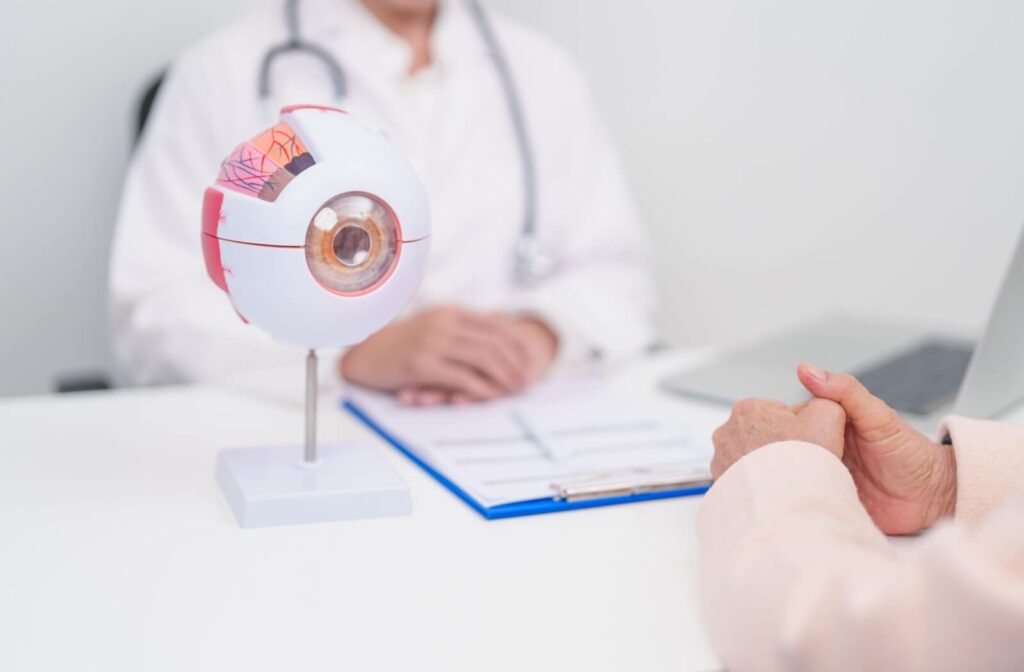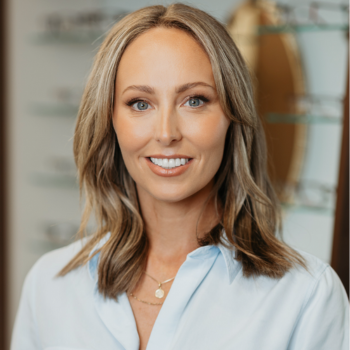You might share your hair colour or your smile with your family, but what about your eye health? Many people wonder if certain eye diseases, like age-related macular degeneration, are passed down from generation to generation.
While having a family history of age-related macular degeneration does increase your risk, genetics are only one piece of the puzzle. A combination of your genes, lifestyle, and other health factors all contribute to the development of the condition. Knowing your family’s health history gives you valuable information to share with your eye doctor during your next comprehensive eye exam.
What Is Age-Related Macular Degeneration?
Age-related macular degeneration (AMD) is an eye condition that affects your central vision. It involves the macula, a small part of your retina responsible for sharp, detailed sight. This is the vision you use for activities like reading, driving, or recognizing faces.
How It Affects Your Vision
AMD primarily impacts your central vision. Your side—or peripheral—vision usually remains unaffected. Early on, you might notice subtle changes, like slight visual distortions or having more trouble seeing clearly in dim light.
The 2 Types Of AMD—Wet & Dry
Dry AMD is the more common form of the condition. It progresses slowly over time as yellowish deposits called drusen build up under the macula. This can cause your central vision to gradually become less clear.
Wet AMD is less common, but it can cause more rapid changes to your vision. This form of AMD happens when new, unstable blood vessels grow under the retina. These vessels can leak fluid, which disrupts the macula and affects your central sight.
The Link Between Family History & AMD
Genetics play a significant role in your likelihood of developing AMD. If a close relative like a parent or sibling has the condition, your chances of also developing it are higher. This makes family history an important factor in assessing your personal risk.
However, having genes linked to AMD doesn’t mean you’ll get it yourself. It simply means your risk is higher. Many other factors contribute to whether you actually develop the condition.
Other Factors That Increase Your Risk
While genetics are a key factor, they aren’t the only one. A combination of genetic predispositions and environmental factors often contributes to the development of AMD. Taking care of your overall health can support your eye health, too.
Who Is at Highest Risk?
- People over 50
- Individuals of European or Asian descent
- People who smoke
- People with high blood pressure or heart disease
- Those with a family history of AMD
Lifestyle Choices & Health Conditions
Your daily habits and general health can influence your risk. For example, diets high in saturated fats and being overweight are linked to a greater chance of developing AMD. Maintaining a balanced lifestyle is beneficial for your entire body—including your eyes.
Signs Of Macular Degeneration
AMD has different stages, and the signs can be very subtle at first. You might not notice any changes until you’ve started to experience vision loss. This is why regular eye exams are so important, as they can help detect AMD even in its earliest stages.
Early & Intermediate Stage Signs
- No noticeable signs in the earliest stage
- Slightly blurry or wavy central vision
- Trouble adjusting from bright to dim light
Late Stage Signs
In the late stage of AMD, central vision loss becomes more apparent. Straight lines might appear distorted or bent. You might also notice a blurry or dark spot in the centre of your vision.

How We Detect & Monitor AMD Progression
Early detection is a key part of managing AMD and protecting your sight. Your optometrist will use a range of tools and technologies to monitor your retinal health closely. This allows us to track changes and recommend an appropriate course of action.
The Role Of Regular Eye Exams
Comprehensive eye exams allow us to look for early signs of AMD, such as the presence of drusen, often before they affect your sight. We can track any changes over time and discuss a plan to manage your eye health.
No-Charge OCT Scans For Early Detection
We offer optical coherence tomography—or OCT—scans at no charge to our clients. This imaging technology provides detailed, cross-sectional pictures of your retina. This is a key tool we use to detect and monitor for progression, even in its earliest stages.
How Fast Does AMD Progress?
The rate of progression is different for each person. Dry AMD typically worsens gradually over several years. In contrast, wet AMD can cause more rapid changes in vision.
Ways To Manage AMD & Protect Your Vision
While there is no cure for AMD, you can take steps to manage the condition and support your long-term eye health. Working closely with an eye doctor helps create a personalized plan that fits your specific needs and lifestyle. Our goal is to help you maintain your vision for years to come.
Lifestyle Changes & Nutrition
Simple changes to your routine can make a positive difference. This includes not smoking, wearing sunglasses to protect your eyes from UV light, and eating a diet rich in leafy green vegetables and fish high in omega-3 fatty acids.
New Treatment Options
Our office offers a number of in-office treatments, including newer therapies Arunalight and Macumira. We can discuss if these options may be suitable for you.
Collaboration For Advanced Care
For those with wet AMD, we work with local ophthalmologists who provide treatments such as anti-VEGF injections. This collaborative approach helps you receive coordinated care from a team of professionals.
Take Care of Your Eyes
Understanding your risk factors for AMD is the first step toward protecting your vision. At iSight Optometry, we focus on comprehensive and preventative eye care for the whole family. Schedule your comprehensive eye exam today to discuss your eye health.





